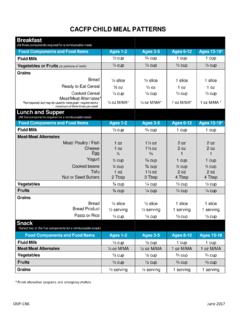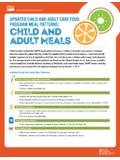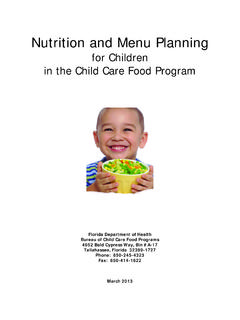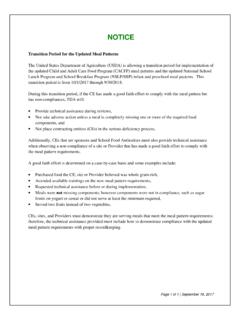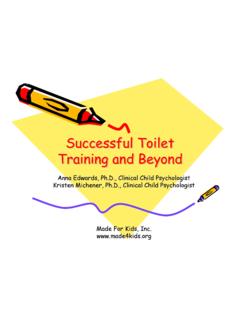Transcription of Service Program - cacfp.org
1 Food and Nutrition Service Park Office Center 3101 Park Center Drive Alexandria VA 22302 DATE: October 19, 2017 MEMO CODE: CACFP 02-2018 SUBJECT: Feeding Infants and Meal Pattern Requirements in the Child and Adult Care Food Program ; Questions and Answers TO: Regional Directors Special Nutrition Programs All Regions State Directors Child Nutrition Programs All States The purpose of this memorandum is to provide guidance on feeding infants and the infant meal pattern requirements in the Child and Adult Care Food Program (CACFP). It also includes Questions and Answers in the Attachment. This revision clarifies meal documentation requirements related to the infant meal pattern, as described in CACFP 17-2017: Documenting meals in the Child and Adult Care Food Program ( ).
2 In addition, it incorporates updated guidance on providing meal accommodations for participants with disabilities as described in CACFP 14-2017, SFSP 10-2017 Modifications to Accommodate Disabilities in the Child and Adult Care Food Program and Summer Food Service Program ( ). This memorandum supersedes CACFP 06-2017: Feeding Infants and Meal Pattern Requirements in the Child and Adult Care Food Program ; Questions and Answers, January 17, 2017. Background On April 25, 2016, USDA s Food and Nutrition Service (FNS) published the final rule Child and Adult Care Food Program : Meal Pattern Revisions Related to the Healthy, Hunger-Free Kids Act of 2010. This final rule amended CACFP regulations at 7 CFR to update the meal pattern requirements. CACFP centers and day care homes had to start complying with the updated meal pattern requirements on October 1, 2017.
3 When developing the updated infant meal patterns , FNS relied on recommendations from the American Academy of Pediatrics (AAP), the leading authority for children s developmental and nutritional needs from birth through 23 months, because the Dietary Guidelines do not currently provide recommendations for children under two years old. This memorandum outlines infant feeding requirements in the CACFP and explains the updated infant meal pattern requirements established in the final rule, including when solid foods must be served. Regional Directors State Directors Page 2 I. OFFERING INFANT meals Infants enrolled for care at a participating CACFP center or day care home must be offered a meal that complies with the CACFP infant meal pattern requirements (7 CFR (b)).
4 CACFP regulations define an enrolled child as a child whose parent or guardian has submitted to an institution a signed document which indicated that the child is enrolled in child care (7 CFR ). A center or day care home may not avoid this obligation by stating that the infant is not enrolled in the CACFP, or by citing logistical or cost barriers to offering infant meals . Decisions on offering Program meals must be based on whether the infant is enrolled for care in a participating CACFP center or day care home, not if the infant is enrolled in the CACFP. Infants do not eat on a strict meal schedule. Instead, infants must be fed during a span of time that is consistent with the infant s eating habits. Infant meals must not be disallowed due solely to the fact that they are not served within the center or day care home s established meal time periods.
5 To learn more about hunger and satiety cues, see FNS Feeding Infants: A Guide for Use in the Child Nutrition Programs, available at FNS is updating the Feeding Infants: A Guide for Use in the Child Nutrition Programs to reflect the updated CACFP infant meal patterns . Creditable Infant Formulas As part of offering a meal that is compliant with the CACFP infant meal pattern requirements, centers and day care homes with infants in their care must offer at least one type of iron-fortified infant formula (7 CFR (b)(2)). The Food and Drug Administration (FDA) defines iron-fortified infant formula as a product which contains 1 milligram or more of iron in a quantity of product that supplies 100 kilocalories when prepared in accordance with label directions for infant consumption (21 CFR (b)(4)(i)).
6 The number of milligrams (mg) of iron per 100 kilocalories (calories) of formula can be found on the Nutrition Facts label of infant formulas. Previously, FNS provided a list of Iron-Fortified Infant Formulas That Do Not Require a Medical Statement. FNS no longer maintains such a list due to the continuous development of new or re-formulated infant formula products. This makes maintaining an accurate, all-inclusive list impractical. Instead, the following criteria may be used to determine whether a formula is eligible for reimbursement: 1. Ensure that the formula is not an FDA Exempt Infant Formula. An exempt infant formula is an infant formula labeled for use by infants who have inborn errors of metabolism or low birth weight, or who otherwise have unusual medical or dietary problems, as defined in 21 CFR More information and a list of FDA Exempt Infant Formulas can be found at: Regional Directors State Directors Page 3 2.
7 Look for Infant Formula with Iron or a similar statement on the front of the formula package. All iron-fortified infant formulas must have this type of statement on the package. 3. Use the Nutrition Facts label as a guide to ensure that the formula is iron-fortified. The nutritive values of each formula are listed on the product s Nutrition Facts label. To be considered iron-fortified, an infant formula must have 1 mg of iron or more per 100 calories of formula when prepared in accordance with label directions. Additionally, to be creditable for reimbursement, infant formula must meet the definition of an infant formula in section 201(z) of the Federal Food, Drug, and Cosmetic Act (21 321(z))1 and meet the requirements for an infant formula under section 412 of the Federal Food, Drug, and Cosmetic Act (21 350a)2 and the regulations at 21 CFR parts 106 and 1073.
8 Requiring an infant formula to be compliant with the FDA regulatory standards on infant formula is consistent with the Special Supplemental Nutrition Program for Women, Infants, and Children s (WIC) infant formula requirements. It also ensures that all infant formulas served in the CACFP meet nutrient specifications and safety requirements. If a formula is purchased outside of the United States, it is likely that the formula is not regulated by the FDA. Infant formulas that are not regulated by the FDA are not creditable in the CACFP. Formulas classified as Exempt Infant Formulas by FDA may be served as a part of a reimbursable meal if the substitution is due to a disability and is supported by a medical statement signed by a licensed physician or a State recognized medical authority.
9 A State recognized medical authority for this purpose is a State licensed health care professional who is authorized to write medical prescriptions under State law. The statement must be submitted and kept on file by the center or day care home. For more information on providing meal accommodations for participants with disabilities, see CACFP 14-2017, SFSP 10-2017 Modifications to Accommodate Disabilities in the Child and Adult Care Food Program and Summer Food Service Program ( ) State agencies should contact their FNS Regional Office when they are uncertain if an infant formula is creditable. 1 Section 201(z) of the Federal Food, Drug, and Cosmetic Act (21 321(z)): 2 Section 412 of the Federal Food, Drug, and Cosmetic Act (21 350a): 3 21 CFR parts 106 and 107: Regional Directors State Directors Page 4 II.
10 PARENT OR GUARDIAN PROVIDED BREASTMILK OR FORMULA An infant s parent or guardian may, at their discretion, decline the infant formula offered by the center or day care home and provide expressed breastmilk or a creditable infant formula instead. meals containing parent or guardian provided expressed breastmilk or creditable infant formula that are served to the infant by the child care provider are eligible for reimbursement, including meals when an infant is only consuming breastmilk or infant formula. Additionally, in recognition of the numerous benefits of breastfeeding, and that the AAP recommends breastmilk as the optimal source of nutrients through the first year of life, centers and day care homes may claim reimbursement of meals when a mother directly breastfeeds her infant at the center or day care home.



